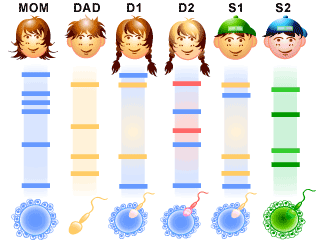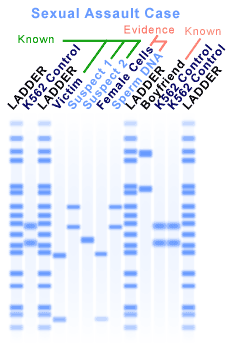A BRIEF TOUR OF DNA FINGERPRINTING
(August, 2003)
Although the structure of DNA is the same throughout all species of plants, animals and microorganisms, each individual organism looks different. This is due to the order in which DNA base pairs are sequenced. Not only does this order make you a human rather than a dog or a daffodil, it also makes each person unique. Sequences of DNA differ from person to person, but every cell within the same person contains the same sequence of DNA. So, your hair, blood, skin and all of the other cells in your body are exactly the same at the molecular level.
This comes in very handy when police are investigating a crime. If a person left a strand of hair, a drop of blood or any other cells at a crime scene, the police will know that that person was there.
But, the human genome contains about 3 billion base pairs of DNA. Examining this large a sequence seems like it would be tedious, time-consuming and expensive, so how is it done?
On some human chromosomes, there are sequences of repeated DNA (9 to 80 base pairs long). The number of repeats can vary from about one to thirty and are not the same from person to person. These sequences are called Variable Number of Tandem Repeats (VNTRs). Within the VNTRs there are sites where an enzyme can cut the DNA, and the location of these sites also varies from person to person. Cutting with the enzyme will lead to DNA fragments of different lengths, which are called Restriction Fragment Length Polymorphisms (RFLPs). These DNA fragments can be separated on an agarose gel based on their size. The RFLPs can be seen by probing using complementary radioactive DNA, and they are used to compare different samples of DNA.
See http://www.pbs.org/wgbh/nova/sheppard/analyze.html for an excellent interactive demonstration of the steps involved in making a DNA fingerprint and using it to solve a crime.
Some RFLPs only occur once in the human genome, while others occur many times on multiple chromosomes.
DNA fingerprinting can be used to identify a child’s parents. Each child inherits one set of chromosomes from each parent. This is why children resemble both of their parents. A child who has a mom with brown hair and blue eyes and a dad with blond hair and brown eyes might end up with brown hair from his mom and brown eyes from his dad. RFLPs are inherited in the same way, some from the mother and some from the father.
In this example, a family consists of a mom and dad, two daughters and two sons. The parents have one daughter and one son together, one daughter is from the mother’s previous marriage, and one son is adopted, sharing no genetic material with either parent. After amplifying the VNTR DNA from each member of the family, it is cut with a restriction enzyme and run on an agarose gel. Here are the results:

It is easy to see in this example that daughter 2 is the child from the mother’s previous marriage and son 2 is adopted. You can see that both daughter 1 and son 1 share RFLPs with both the mom and dad (coloured blue and yellow respectively), while daughter 2 has RFLPs of the mom but not the dad, and son 2 does not have RFLPs from either parent.
Even if the RFLPs were not colour coded, you could still distinguish the parents of the children by looking at the position of the bands in the agarose gel. In reality, all of the bands look the same and only the positions are different.
DNA fingerprints can be used to determine the identity of a child’s parents if they are unknown. Generally, it is the father whose identity is in question, although in adoptions the biological mother’s identity could also be questioned years later. In the previous example, if the father of daughter 2 was alleged to be the dad in the example, DNA fingerprinting would prove that he is not, since none of his RFLPs line up with the daughters. DNA fingerprinting can also prove the identities of biological parents in the case of adoption.
The police use the same analysis to determine the identity of a person at a crime scene. After collecting a DNA samples from the scene and any suspects, the police amplify the VNTRs and digest the DNA with a restriction enzyme. The samples are run on an agarose gel, and the bands found at the crime scene are aligned with those of the suspects’. DNA fingerprints can do two things, they can either prove someone’s innocence, or prove their guilt.
The next example shows how DNA fingerprinting can point to a criminal. DNA samples were taken from a crime scene, the female victim and two suspects in a sexual assault case. The victim’s boyfriend was also tested. The DNA ladders are used to judge the sizes of the DNA fragments. Control samples are also run, to ensure that the experiment is done correctly. Can you determine which suspect is likely the criminal?

The DNA fingerprint from suspect 1 matches up with the fingerprint of the sperm DNA from the crime scene. You can also see that the female cells from the scene match the victim’s DNA.
As with anything, however, there are some problems with DNA fingerprinting. First of all, depending on how many VNTRs are amplified and analyzed, there is a possibility that different people could have the same pattern. The analysis might be specific enough that only 1 person in 20 billion people would have the same pattern, indicating an almost definite match. If it is not very specific however, there could be a chance that 1 person in 20 would have the same pattern. For this reason, in criminal cases, the analysis must use rare VNTRs in combination to get a pattern that is specific for the culprit.
Also, DNA from a crime scene is frequently dirty. There is generally some contamination from the outside environment. If the crime scene is old, the DNA evidence might have degraded, or broken down, and if there was more than one person at the scene, the sample might be a mixture of more than one person’s DNA. In addition, just because someone’s DNA is found at a crime scene does not mean that they committed the crime. For example, you might go into a convenience store and a strand of your hair might fall on the floor. If that convenience store is robbed later that night, your DNA could be found at the scene, but you were at home when the robbery occurred. This is why DNA evidence must be combined with traditional forms of evidence such as eyewitness accounts.
In spite of the problems with DNA fingerprinting, it is a reliable form of evidence when performed properly, which has helped falsely convicted people be released from jail. One well-known Canadian example is that of Guy Paul Morin. Morin was convicted of murder in 1992 and sentenced to prison for 25 years with no chance of parole. In 1995, DNA evidence demonstrated that Morin was not the killer, and he was released. There are many other cases of people released from jail after being cleared by DNA fingerprinting. See a list of some of them here: http://www.pbs.org/wgbh/nova/sheppard/cleared.html
(Art by Jane Wang – note that high res versions of image files available here)